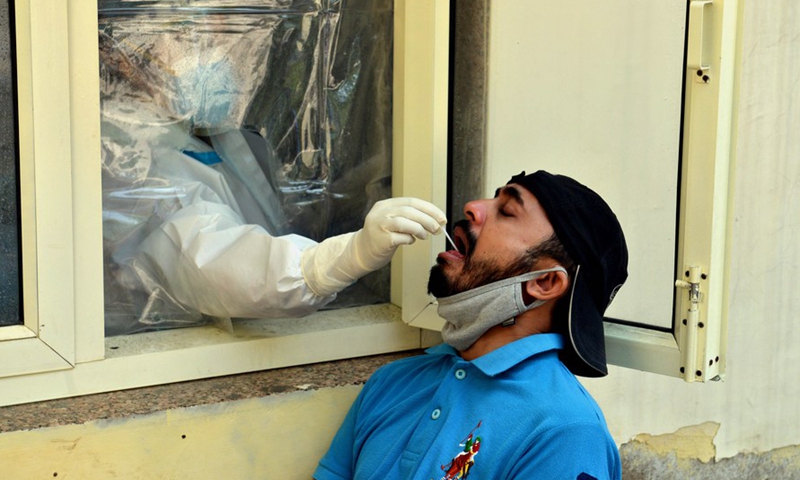Global pandemic’s 2nd wave 'likely to peak in December’
By Xu Keyue Source: Global Times Published: 2020/10/12 21:03:40
Europe braces as East Asia eases earlier controls

A health worker takes a sample from a man for COVID-19 screening at a hospital in New Delhi, India, Oct. 11, 2020. India's COVID-19 tally surpassed 7 million on Sunday, reaching 7,053,806, as the death toll reached 108,334, announced the federal health ministry. (Photo by Partha Sarkar/Xinhua)
As many parts of the world face a rebound in COVID-19 cases, with almost all European countries tightening their anti-epidemic measures and local media claiming the second wave of the pandemic has begun, Chinese medical experts predicted that the latest wave is likely to peak in December and January 2021, but will be less worrisome than the first wave.
Yang Gonghuan, former vice director of China's CDC, told the Global Times that with the arrival of fall and winter in the northern hemisphere, coronavirus has gained fresh momentum as temperatures drop, leading to an inevitable rebound in infections around the world.
The amount of virus deposited in Europe and the US is very large, which explains the growing number of confirmed cases, Yang said.
Europe reported 100,000 daily COVID-19 cases for the first time on Thursday, surpassing the numbers in the hard-hit US. The World Health Organization urged Europe to stem the rise in cases and curb mass gatherings.
France is one of the hardest-hit countries in the second wave in Europe. It reported another 102,925 confirmed cases last week, the country's one-week high. Paris, Marseille and the overseas territory of Guadeloupe have also been put on maximum alert in recent weeks, leading to the closure of bars and cafes. Other countries, including Italy, the UK and Germany are also preparing fresh restrictions.
"Daily testing capacity has been expanding continuously, which is another factor. However, the death toll continues to drop, thanks to the experiences from the past 10 months," Yang said.
While the second wave of COVID-19 is inevitable, Yang believes that it will be less worrisome than the first.
The mortality rate has been dropping in many countries. As of press time, the number of global confirmed cases reached 37,544,120, with a death toll of 1,077,082, according to data from the Johns Hopkins University.
Echoing Yang Gonghuan, Yang Zhanqiu, deputy director of the pathogen biology department at Wuhan University, told the Global Times on Monday that COVID-19 cases would surge from October, and are expected to peak in December and next January.
Yang Zhanqiu said the second wave of the pandemic would be far less severe than the first, with sporadic outbreaks in parts of the world.
Liang Manchun, associate research fellow at the Institute for Public Safety Research of Tsinghua University, who has been closely following the epidemic, told the Global Times on Monday that based on their team's research model, the pandemic may see about 400,000 cases a day this October.
However, Liang noted that anti-epidemic work would influence the development of the pandemic.
"Although cooler weather could make the virus more active, it has its advantages. People go out less, which can ensure social distancing," Liang said. "Personal protection measures and national restrictions in response to the epidemic really matter."
But the epidemic forecast in the US remains gloomy. The US reported 44,614 new cases on Sunday, bringing the total number to 7,762,546 as of press time, data from the Johns Hopkins University shows.
Liang and his team predicted that the epidemic in the US could peak in October with 70,000 to 80,000 cases a day, similar to June.
The epidemic in India is also bouncing back sharply, with more than 7 million cases. Experts predict that it may soon overtake the US in the number of confirmed cases.
Countries in Asia, including China and Japan, are easing their epidemic prevention and control measures after they took stringent measures since the first wave of the outbreak, and have started to recover from the crisis.
As for China's situation in the upcoming resurgence of COVID-19, Wu Zunyou, chief epidemiologist at China's CDC, told China Central Television on Saturday that the just-concluded National Day holidays could be seen as a "major test" of the country's epidemic prevention and control capabilities.
With the largest crowds seen since the pandemic hit the country, Wu believes that China has withstood the test, as no new domestic cases were reported during the holidays.
The Japanese government is also planning to lift its current travel ban for 12 countries and regions - including China - starting November. The country reported 438 cases on Sunday, much less than its high of 1,726 on July 30.
Posted in: SOCIETY